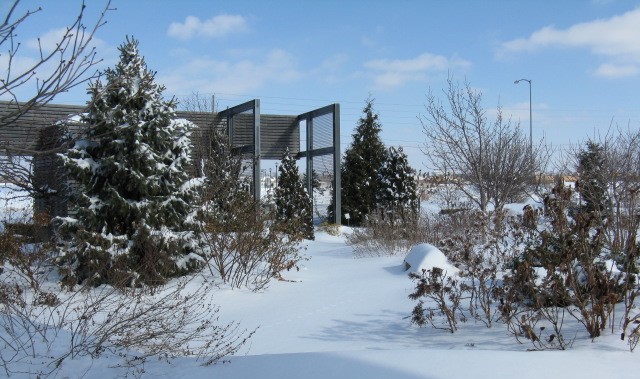Create Year-Round Interest by Thoughtful Placement of 'Garden Bones'
By Dennis Patton, Horticulture Agent
Does your landscape appear interesting and appealing throughout the year? If not, you may be lacking the elements that create year-round interest. This year-round interest is referred to as the bones of the garden.
Garden bones are elements that add interest, color, or structure to catch the eye. Shades of brown and tan are beautiful in large spaces like the Flint Hills but can appear monochromatic in the smaller areas surrounding your home. Winter can already be bleak, adding to the dull winter blues.
Adding bones and needed winter year-round interest can be accomplished by dotting the landscape with evergreens. The pop of color and their natural growth structure help create interest, playing off the winter landscape's duller, less bold shades.
Evergreens are essential and should always be found in a well-landscaped home. The plant materials in the entrance planting should be at least one-third evergreen. This basic landscape rule can be applied throughout the entire garden, not just the front.
The one-third rule for the entrance planting provides year-round interest while allowing enough space for other seasons, such as spring and summer flowers and fall colors. Too many evergreens do not create the landscape changes throughout the year to add more interest. They are static, changing little throughout the year, and can be overused.
Surprisingly, evergreens are not just green. Shades of blue-gray may be found in spruces, and yellow golds are common in junipers or false cypress. Adding a variety of colors increases the dramatic effect of the winter bones.
Besides color, form and texture can also help add winter interest. Even deciduous plants have interesting structures or textures, creating interest. Weeping or columnar shapes make strong accents to catch the eye.
Evergreens develop the best bones. Good bones are achieved by planting evergreens with varying spreading, upright, weeping, or rounded habits.
A good approach when adding your bones is to stand inside the home and look out. What do you see, a winter scene that holds your attention? Well-placed bones should be visible from the inside of your house.
Bones are year-round focal points. They need to shine from many angles. Group or mass them to soften the home or draw attention to the door in front of the house.
Bones in the backyard can be planted in mass or used as accents. Mass plantings include groupings of evergreen trees that add beauty and function, such as a windbreak or screen. Accents are created by placing a single plant in a prime location that helps pull the landscape together, causing the eye to stop, linger, and make that much-needed interest focal point. It only takes a few accents to create the bones when placed in key visual areas.
These cold winter days are perfect for standing at the window and gazing into the yard. Let your eyes and mind wander, and quickly, you will know where the bones should find a place in the garden.
Return to Trees and Shrubs Agent Articles


